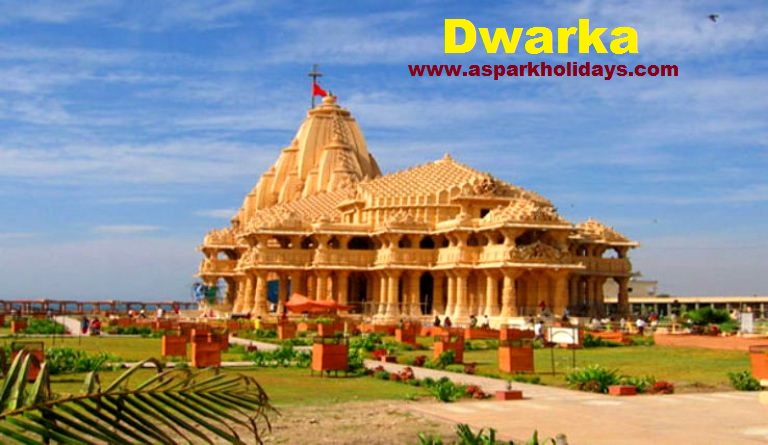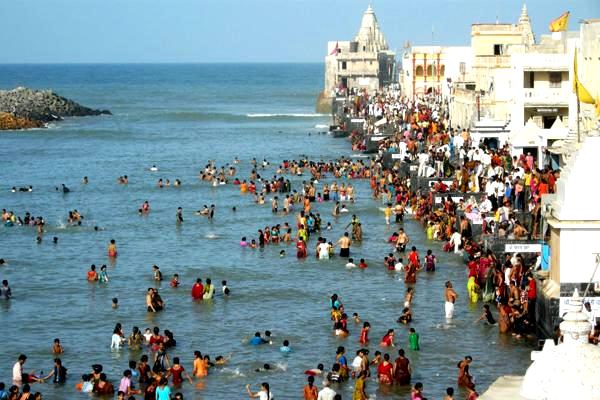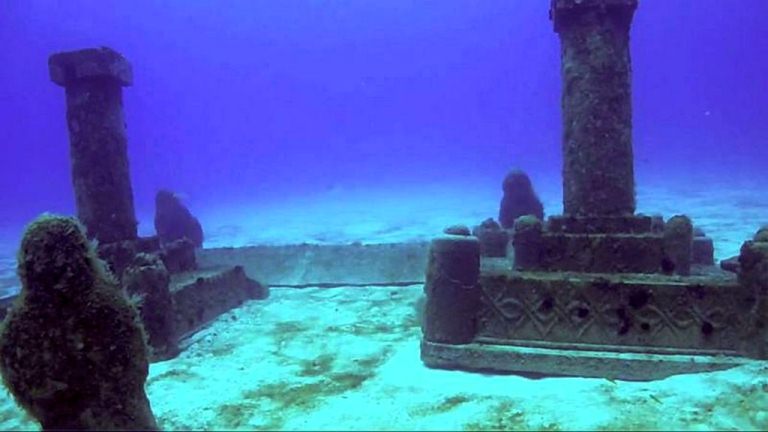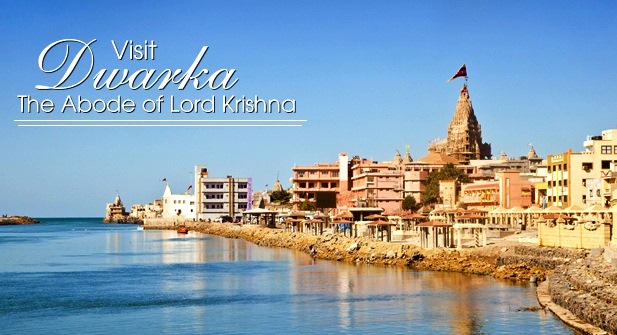
Dwarka is a significant pilgrimage center in India. This place is steeped in legends. The life of Lord Krishna is associated with Dwarka. In Puranic times, Dwarka was called by the name of Dwaravati or Kushasthali. It basked in the glory of being the most important location on the Saurashtra coast. It is believed that after slaying Kansa, Lord Krishna left his residence at Mathura. He traveled with his entire Yadava community, reached the coast of Saurashtra and founded a town called Swarnadwarika.
According to legend, when Lord Krishna was dying, he asked his devotees to go away from Swarnadwarika so that it could be engulfed by the sea. Until this day, the beloved city of Lord Krishna lies buried under the sea. Excavations have exposed the fact that the sea swallowed a total of five settlements. However, the present-day Dwaraka, the sixth in the line, was spared.
Vajranabh, the successor and great grandson of Lord Krishna, is believed to have constructed the present temple Dwarakanath, which is also known as Trilok Sundar. This temple is an integral part of the History of Dwarka. Many Hindus fervently think that this temple was built in one night by a mystic agency, under the direction of Vajranabh.
According to Dwarka History, the original inhabitants of this region are called Kabas, Kalas and Modas. The Modas and Kabas now appear to be extinct. However, the present-day Vaghers are believed to have descended from the Kabas.
So, book yourself for a Dwarka Tour at your earliest and enjoy your sojourn to this beautiful place.
Places to Visit in Dwarka- Dwarka is an important Hindu pilgrimage city and is also known as the kingdom of Lord Krishna. Being one of the four major pilgrim places for Hindus, the city is a part of the "Char Dham" Yatra. Many tourists and devotees visit this city throughout the year.
Places to See in Dwarka- The city of Dwarka is mostly famous for its temples as the place is of mythological significance. Some of the popular tourist attractions in Dwarka are given below.
Somnath Temple- The Somnath Temple represents one of the 12 Jyotirlingas of Lord Shiva and refers to the protector of Moon God. The temple is situated in Prabhas Kshetra near Veraval. The temple has been destroyed and reconstructed six times and thus, it is known as 'The Shrine Eternal.
It is said that the Moon God built the temple in gold, the demon king Ravana in silver and Lord Krishna in wood. The temple is built in the famous Chalukya architectural style. Pleased by the prayers of Moon God, Lord Shiva decided to rest in this temple as a Jyotirlinga for eternity.
Dwarka Lighthouse- Dwarka Lighthouse is located at Rupen Creek. In 1866, the 18 m tall square tower was constructed at this site, along with an installation of an oil wick lamp. The present day tower is around 43 metres high and was built between 1960 and 1962. The lighthouse was inaugurated on July 15, 1962. From the lighthouse, people can see the panoramic views and lovely sunsets.
The place is open to tourists in the evening from 4:30 pm to 6 pm and the admission fee is free.
Dwarkadhish Temple- The Dwarkadhish Temple which is also known as the Jagat Temple was built in the 16th century. The original temple was constructed by King Vajranabha, the great grandson of Lord Krishna. The five storied temple is constructed using sand and limestone with a 70.5 metres high spire and has a platform area of 1800 sq. ft. The temple comprises of a shrine and has a temple dome with a 24 m long multi-colored flag, with symbols of sun and moon.
Nageshwar Jyotirlinga Temple- The Nageshwar Jyotirlinga Temple is also known as the Nagnath temple and is situated in the outskirts of Dwarka. It's a famous Lord Shiva Shrine in India and one of the 12 Jyotirlingas mentioned in the Shiva Purana. The lingam enshrined in the temple is of Nageshwara Mahadev, who symbolizes protection from all kinds of poison.
The main highlight is the giant statue of Nageshwara Mahadev Shiva Lingam. The temple is unique as the Shiva Lingam faces south and the Gomugam faces east. The Shivaratri festival is celebrated at this temple in grand style at this temple and is attended by thousands of devotees.
Rukshamanee Mandir- The Rukshamanee Mandir is dedicated to Devi Rukmani, the wife of Lord Krishna. Lord Krishna had 16,108 wives and Devi Rukmani was his favourite. The temple walls features a variety of paintings from the 12th century.
The paintings capture the time spent by Devi Rukmani and Lord Krishna. A marble deity of Devi Rukmani, with four hands or 'Chaturbhuja' is placed in the temple. These hands clasp Shanka, Chakra, Gada and Padma, symbolizing her as the reincarnation of Goddess Maha Lakshmi.
Beyt Dwarka- The Beyt Dwarka is an island located around 30 km from the main town of Dwarka. The temple was built by Sri Vallabhacharya and is over 500 years old. The island is enclosed by a few temples, white sand beach and coral reefs. The key temple at the island is of Lord Krishna, which is said to be placed at a site which was once the residence of Lord Krishna and His family. There are addition temples on this island. The street which leads to these temples remain crowded with vendors selling idols, local crafts, etc. The beach is also popular among tourists for its marine life, water sports, sea excursions, camping and picnics.
Gomati Sangam Ghat- The Gomati Sangam Ghat is a sacred place where the river Gomati flows. The ghat can be reached from the Swarga Dwar of the Dwarkadhish Temple by climbing down 56 steps. There are more than 12 ghats on the river Gomati and the point where the river meets the ocean is known as the Gomati Sangam. It is considered sacred to take bath at this point. The Ghat has many temples and smaller shrines of Lord Krishna and his friend Sudama. The temples can be reached by hiring a boat.
Gita Mandir- The Gita Mandir temple was built in 1970 by the industrialist family of Birla. The temple is built using marble and protects the values and teachings of 'Bhagavad Gita', the religious book of Hindus. The temple walls are carved with hymns from Bhagavad Gita and the temple ceiling is designed in a special way so that every voice in the hall is echoed.
How to Reach Dwarka- The distance from Gujarat's largest city Ahmedabad to Dwarka is around 438 km on the main highways and the distance from Jamnagar to Dwarka is around 133 km. These two cities are well connected to Dwarka city with all means of transportation.
By Air- The nearest airport to Dwarka is in Jamnagar about 127 km away. The Mumbai International Airport connects almost all the flights from India to Jamnagar. From the Jamnagar Airport, one can hire a taxi or take a bus to reach Dwarka.
By Train- The city of Dwarka has its own Railway station just about 1.5 km from the main city. The railway station lies on the Western Railway network and is well-connected with Jamnagar, Mumbai and other major cities of India.
Express trains connect daily from Ahmedabad to Dwarka, as Ahmedabad is the nearest major railway junction. A few train names have being given below.
By Road- Dwarka is well linked by State highways to other cities and states in India. The State Transport Corporation connects Dwarka with major cities and towns of Gujarat and other states as well. Private luxury buses and tourist buses are also available from neighboring cities to Dwarka. Once in Dwarka local buses and cycle rickshaws are best to explore the city and the nearby temples.
Need Aspark Help?
For Tour Packages, Vehicle Rental and Customer Care Support.
+91 9999 31 7846
booking@asparkholidays.comWhy Travel with Us?

Excellent Support
Our Team Available 24x7 for Customer support
Best Price & Savings
We Offer the Most Competitive Prices.



